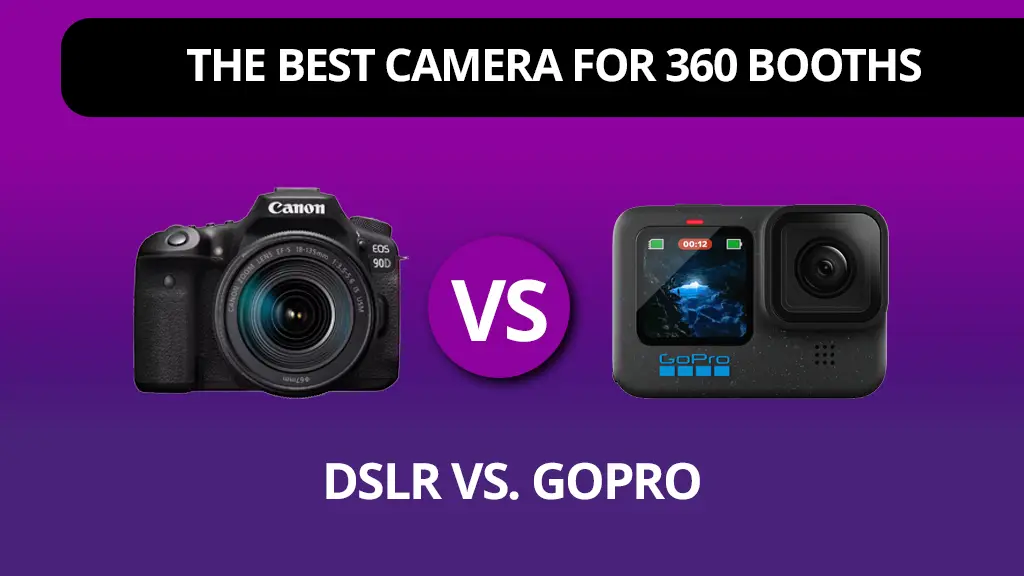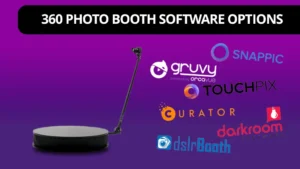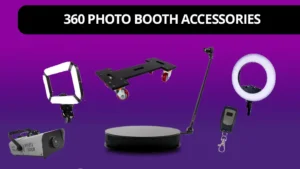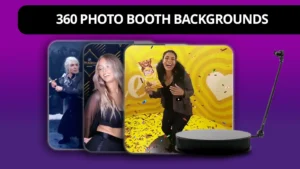Choosing the right camera for your 360 photo booth is crucial for capturing high-quality, dynamic videos. The camera you select will impact the clarity, stability, and overall visual appeal of the final product. This guide explores the best cameras for 360 photo booths , considering factors such as resolution, low-light performance, focal length options, frame rate, and ease of use.
Table of Contents
Key Considerations When Choosing a Camera For a 360 Photo Booth
- Resolution
- Importance: High resolution is essential for capturing sharp and clear videos. Higher resolution cameras provide better detail and clarity, which is crucial for professional-quality outputs.
- Recommendation: Look for cameras that offer at least 1080p resolution for social media images, and 4K being ideal for the highest quality cinematic shots.
- Low-Light Performance
- Importance: Many events take place in low-light environments, such as parties or weddings. A camera with good low-light performance ensures clear and bright videos, even in challenging lighting conditions.
- Recommendation: Cameras with larger sensors and better ISO performance excel in low-light situations.
- Frame Rate
- Importance: A higher frame rate allows for smoother video playback and the ability to create slow-motion effects. This can enhance the dynamic feel of the 360-degree videos.
- Recommendation: Choose cameras that can shoot at least 60 frames per second (fps) for standard 1/2 speed slow-motion capability, with higher frame rates available for more dramatic slow-motion.
- Ease of Use
- Importance: The camera should be user-friendly and easy to set up and operate, especially during events where quick adjustments may be needed.
- Recommendation: Look for cameras with intuitive interfaces and easy connectivity options.
Best Camera Options for 360 Photo Booths
- DSLR Cameras
- Example: Canon EOS 90D
- Features: DSLR cameras like the Canon EOS 90D offer excellent image quality, high resolution (1080p @ 60fps), and good low-light performance. They also provide manual controls for fine-tuning exposure settings.
- Pros: High resolution, interchangeable lenses, exposure control, robust build quality.
- Cons: Larger and heavier than other options, more complex to operate.
- Mirrorless Cameras
- Example: Sony Alpha a6400
- Features: Mirrorless cameras such as the Sony Alpha a6400 are known for their compact size, high resolution (1080p at 120fps), and excellent autofocus capabilities. They also perform very well in low-light conditions.
- Pros: Compact and lightweight, fast autofocus, higher resolution at higher frame rates.
- Cons: Shorter battery life compared to DSLRs.
- Action Cameras
- Example: GoPro HERO12 Black
- Features: Action cameras like the GoPro HERO12 Black are renowned for their durability, wide-angle lenses, and high frame rates (up to 240 fps). They are ideal for capturing dynamic, high-energy footage.
- Pros: Durable, easily connect to multiple photo booth softwares, high frame rates, easy to mount and use.
- Cons: Smaller sensor size, lower resolution and no aperture control compared to DSLRs and mirrorless cameras.
Advanced Features to Consider
- Image Stabilization
- Importance: Image stabilization helps to reduce camera shake and produce smooth, stable videos. This is particularly important for 360 photo booths without decoupled issolation like the OrcaVue XL.
- Recommendation: Look for cameras with built-in optical or electronic image stabilization.
- Connectivity Options
- Importance: The rotating arm makes wired connections to a camera an impossibility with 360 photo booths. Good connectivity options make it easier to transfer files, control the camera remotely, and integrate with other equipment.
- Recommendation: Choose cameras with Wi-Fi and Bluetooth connectivity.
- Battery Life
- Importance: Longer battery life ensures that the camera can operate throughout the event without frequent interruptions for battery changes.
- Recommendation: Consider cameras with long-lasting batteries or the option to use external power sources.
- Software Compatibility
- Importance: The camera should be compatible with the software used for capturing, editing, and sharing the videos.
- Recommendation: Ensure that the camera works seamlessly with your chosen video editing and sharing software.
Camera Accessories
- Lenses
- Description: Interchangeable lenses allow for greater flexibility in capturing different types of shots.
- Types: Wide-angle lenses, zoom lenses, and prime lenses can all be useful depending on the event and desired video style.
- Selection Tips: Choose lenses with low aperture settings for low-light performance and beautiful blurry backgrounds.
- Memory Cards
- Description: High-capacity memory cards are essential for storing large video files.
- Types: SD cards, microSD cards, and CF cards are commonly used.
- Specifications: Choose cards with high write speeds to ensure smooth recording and quick data transfer.
Tips for Using Cameras with 360 Photo Booths
- Calibration and Testing
- Description: Before the event, calibrate the camera settings and run test recordings to ensure optimal performance.
- Steps: Adjust focus, exposure, and white balance according to the lighting conditions of the venue.
- Maintenance and Care
- Description: Regular maintenance of the camera and accessories ensures longevity and reliability.
- Tasks: Clean lenses, check for firmware updates, and inspect for any damage before and after each event.
- Training and Practice
- Description: Proper training and practice are essential for mastering the use of the camera and achieving the best results.
- Training Methods: Attend workshops, watch tutorials, and practice different shooting techniques to improve your skills.
- Backup Equipment
- Description: Having backup equipment ensures that you are prepared for any technical issues that may arise during the event.
- Items to Include: Spare batteries, extra memory cards, and a secondary camera can be lifesavers in case of unexpected problems.
Best Cameras for 360 Photo Booths – Conclusion
Selecting the best camera for your 360 photo booth is a critical decision that affects the quality and appeal of your videos. By considering factors such as resolution, low-light performance, frame rate, and ease of use, you can choose a camera that meets your needs and enhances your services. Whether you opt for a DSLR, mirrorless, action, or 360-degree camera, each has its strengths and applications. Investing in the right camera and accessories, combined with proper maintenance and practice, will ensure that your 360 photo booth delivers professional and engaging results at every event.




